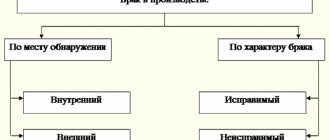Determination of NMCC using comparable market prices
Determining NMCC using comparable market prices is an analysis of price offers for similar goods, works or services, taking into account the commercial and financial conditions of the planned order. Based on this analysis and the data obtained, the maximum cost is established. Let us examine in more detail how the NMCC is justified using the method of comparable market prices; you will find an example of such a calculation below. In essence, the comparable market price method of market analysis is to predict the cost of purchases based on prices for identical goods, and in their absence, for similar goods.
What sources of information can you use?
Taxpayers who wish to voluntarily apply market prices, or who collect documents at the request of the Federal Tax Service, have the right to use any available sources of information.
But there are restrictions for tax authorities. When checking market prices, employees of the Federal Tax Service of Russia must find out whether the company being inspected has made comparable transactions with independent parties. If it did, then information about such transactions should be used when controlling prices for “interdependent” transactions. No other sources can be used in this case.
And only if the audited organization did not have comparable transactions with independent persons, tax authorities are allowed to obtain information from outside. You can use the following information:
- information on prices and quotes on Russian and foreign exchanges;
- customs statistics of foreign trade of the Russian Federation;
- information on prices, limits of price fluctuations and stock quotes from Russian and foreign official sources and from publicly available publications and information systems;
- data from information and pricing agencies;
- information about any other transactions of the taxpayer being audited.
If nothing from the above list could be found, or the information turned out to be too scarce, auditors from the Federal Tax Service have the right to use the data from accounting and statistical reporting. In addition, fiscal officials can obtain information from appraisers.
Let's look at the differences between these groups
Identical products have the same functional, technical, quality, performance characteristics, country of origin and manufacturer. In this case, minor differences in appearance do not matter. For example, two cars that are identical in all respects (same brand, same configuration, etc.), but differ in color. The latter is considered a discrepancy regarding appearance.
Similar products have comparable characteristics and consist of similar components, with the same quality, country of origin and reputation in the market. Perform the same functions and can be commercially interchanged. For example, two winter-type rubber tires, studded, identical in size, speed index and load, manufactured in the same country, but by two different manufacturers with different trademarks. Both tires are made to the same standard, from the same materials, have the same reputation in the market, and are therefore homogeneous.
It should be taken into account that commercial offers from suppliers must contain an indication of specific goods, having a trademark, model and other parameters. Having studied them, the customer will be able to understand whether they are offering identical or homogeneous goods.
BRINGING INDICATORS INTO A COMPARABLE FORM
Home Favorites Random article Educational New additions Feedback FAQThe main ways to bring indicators into a comparable form are to neutralize the impact of cost, volume, quality and structural factors by bringing them to a basis, as well as the use of averages, relative values, correction factors, etc. In market conditions, a special place is given to the price index. Using the price index, the most important cost indicators are recalculated from actual to comparable ones. For this purpose, the indicator that needs to be brought into a comparable form is multiplied or divided (depending on the base level to which the indicator is reduced) by consumer price indices using the “chain method”.
Example : there are data on revenue from sales of products by year.
Table 3 - Revenue from sales of products in actual estimates
| Indicators | 2007 | 2008 | 2009 | 2010 | 2011 | 2012 |
| Sales revenue at current prices (N) | ||||||
| Consumer Price Index (I) | 1,119 | 1,133 | 1,088 | 1,088 | 1,061 | 1,066 |
| Sales revenue in 2012 prices |
To calculate revenue in a comparable 2012 estimate, you need to:
N11 12 = N11 * I12
N10 12 = N10 * I11* I12
N09 12 = N09 * I10* I11* I12
N08 12 = N08 * I09* I10* I11 * I12
N07 12 = N07 *I08 * I09* I10* I11 * I12
Task 3. Bring sales revenue into a comparable form. Draw conclusions.
Table 4 – Revenue from sales of products in comparable valuation
| Index | 2007 | 2008 | 2009 | 2010 | 2011 | 2012 | 2012 as a percentage of 2007 |
| Production volume, t | 240,6 | 303,3 | 294,5 | 310,2 | 368,7 | 353,8 | |
| Price for 1 ton of products, rub. | |||||||
| Revenue in current prices, thousand rubles. | |||||||
| Revenue in 2012 prices, thousand rubles. |
Conclusion:
Task 4. Analyze the dynamics of the cost per unit of production using absolute and relative deviations
Table 5 – Dynamics of unit cost of production in comparison with the level of 2012
| Year | Cost, rub. | Absolute growth, rub. | Rates of growth, % | Growth rate, % | ||
| To previous level | To entry level | chain | basic | chain | basic | |
| 907,0 | — | — | — | — | — | — |
| 884,4 | ||||||
| 879,8 | ||||||
| 740,6 |
1.3 MULTIDIMENSIONAL COMPARATIVE ANALYSIS (METHODOLOGY OF RATING ANALYSIS)
One of the analysis options that allows you to obtain a comprehensive assessment of the state of the organization and compare them is rating analysis. The rating is based on a generalized characteristic for a certain characteristic, which allows organizations to be arranged in a certain sequence in ascending or descending order of this characteristic.
Signs of classification of organizations can reflect individual aspects of their activities (profitability, liquidity, etc.), as well as the activities of organizations as a whole.
The list of indicators included in the calculation can be varied, but the main requirement for them is that they have the same focus.
Task 5. Conduct a rating assessment of the organization
1. The system of indicators is justified.
Initial data of the enterprise in the form of a matrix (Aij), where indicators (i) are reflected in the rows, and indicators are reflected in the rows of the enterprise (j).
Table 6 – Initial data matrix (Aij)
| Indicators (i) | Organizations (j) | Reference | |
| 1. Sales proceeds, thousand rubles. | |||
| 2. Profit from sale, thousand rubles. | |||
| 3. Return on sales, % | 8,4 | 6,9 | 12,6 |
| 4. Return on equity, % | 48,6 | 57,9 | 35,7 |
2. For each indicator, we find the maximum value (max ij), which is entered in the column of the conditional reference organization.
3. Initial indicators (Aij) are standardized in relation to the corresponding indicator of the reference organization and are defined as Хij.
Aij
Хij = ————
max ij
Xij values are entered into a new matrix
Table 7 – Matrix of standardized data (Хij)
| Indicators (i) | Organizations (j) |
| 1. Sales proceeds, thousand rubles. | |
| 2. Profit from sale, thousand rubles. | |
| 3. Return on sales, % | |
| 4. Return on equity, % |
Sending inquiries to suppliers
Clause 3.7.1 of the Order of the Ministry of Economic Development of Russia dated October 2, 2013 No. 567 indicates the need to send five requests. However, the Resolution of the Arbitration Court of the Northwestern District dated March 27, 2015 in case No. A42-2927/2014 disputes this fact and indicates that the customer independently determines the number of requests that are necessary to determine the NMCC. We discussed in detail the algorithm for obtaining a commercial proposal and the necessary samples in the article “We are preparing a request for commercial proposals.”
Publication of requests in the Unified Information System (hereinafter referred to as the UIS)
A sample of such a request for publication in the EIS
Request for quotations No. (rev. No. 01)
General RFQ information:
Request number
Status
Name of the organization placing the request for prices
Name of the procurement object
Carrying out this information collection procedure does not entail any obligations for the customer.
From the response to the request, the price of a unit of goods, work, services and the total contract price on the terms specified in the request, the validity period of the proposed price, the calculation of such a price in order to prevent deliberate overestimation or underestimation of the prices of goods, works, services must be determined
Place where price information is provided
Responsible official collecting price information
Email address, Contact phone number, Fax
Deadlines for providing price information:
Start date and time for providing price information (local time)
End date and time for providing price information (local time)
Estimated timing of the procurement
Information about the object of purchase / information about goods, works and services:
Description of the procurement object
Information defining the identity or homogeneity of a product, work, service
Requirements for the terms of the contract:
Basic conditions for the execution of the contract concluded based on the results of the procurement
Payment procedure, Amount of contract security
Requirements for the warranty period of goods, work, services and (or) the scope of providing guarantees of their quality
Requirements for the procedure for supplying goods, performing work, and providing services
Applications:
1 Terms of reference
2 Response form to request
Analysis of the register of EIS contracts
The Ministry of Economy recommends that customers use information only on contracts that were executed without collecting penalties over the last three years (clause 3.7.3, as well as Appendix No. 2 of Order No. 567). The price of the analyzed contracts can be increased depending on the method of ordering: competition - the cost can be increased by no more than 10%; auction - 13%; request for quotes - 17%; request for proposals - 17%; from a single supplier - not subject to adjustment.
Resale price method
It has priority in the case where one related party bought a product from another related party and then sold it to an independent party without processing. At the time of resale, division into lots, sorting, repackaging and mixing of goods is permissible. At the same time, the participant who bought and then sold the goods should not own intangible assets that would significantly affect the price of the transaction.
The essence of the method is to determine the interval of gross profitability for several comparable transactions and check whether the profitability of the controlled transaction falls within this interval.
Gross margin is gross profit divided by sales revenue (excluding excise taxes and VAT). The data is taken from the financial statements at the time of the transaction, but no later than December 31 of the same year, or from the statements for the three previous years.
The interval is determined in the same way as with the market price comparability method, but instead of price indicators, gross profitability indicators must be considered.
If the gross profitability of a controlled transaction falls within the interval, then the price of this transaction corresponds to the market price. If the gross profitability of the transaction under review is less than the minimum value of the interval, then taxes should be calculated based on the minimum value. If the gross profitability of the transaction under review is greater than the maximum value of the interval, then taxes should be calculated based on the maximum value.
Calculation of NMCC using the method of comparable market prices (Example)
//44fzrf.ru/pismo-fas-699/
You might be interested in:
- JUSTIFICATION OF NMTC AND INITIAL UNIT PRICE OF PRODUCT
- DEFINITION OF NMCC. DESIGN AND ESTIMATE METHOD
- PROCEDURE FOR CALCULATION OF NMTC WHEN PURCHASING FUEL WITHIN THE FRAMEWORK OF LAW No. 44-FZ
- HOMOGENEOUS AND IDENTICAL GOODS
- REQUEST FOR PRICE INFORMATION
- HOW TO CALCULATE THE PRICE OF A CONTRACT WITH A SOLE SUPPLIER, contractor, performer
- RULES FOR PROCUREMENT OF MEDICINES
- HOW TO PURCHASE STATIONERY SUPPLIES
- OVERVIEW OF VIOLATIONS AND DISADVANTAGES
- ENSURING WARRANTY OBLIGATIONS 44 Federal Law
The rationale for the NMCc should be in the 2021 schedule
Until January 1, 2021, the calculation and justification of the NMC must be included directly in the schedule, for example, by attaching to it a separate document (file) containing such justification. This is due to Part 3 of Art. 18 of Law No. 44-FZ. Despite the fact that Part 3 of Art. 18 of Law No. 44-FZ will lose its force from October 1, 2021; the justification for the NMC schedule for 2021 must be drawn up before the end of 2021. According to Part 6 of Art. 2 of the Federal Law of 01.05.2019 No. 71-FZ “On Amendments to the Federal Law “On the Contract System in the Sphere of Procurement of Goods, Works, Services to Meet State and Municipal Needs” procurement planning for 2021 is carried out according to the rules in force before the entry into force by virtue of this federal law.
The absence of calculations and justification directly in the procurement schedule for 2021 forms an administrative structure, the responsibility for which is provided for in Part 1 of Art. 7.29.3. Code of Administrative Offenses of the Russian Federation in the form of an administrative fine in the amount of 20,000 to 50,000 rubles.







